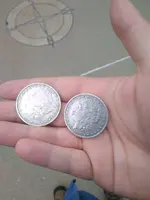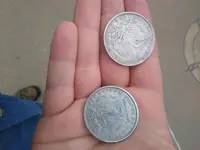How can the 'coin' be called a counterfeit or replica ( or even a coin) since that particular date with the CC mint mark never existed? How do you counterfeit or replicate something that never existed? I think of it as a fantasy 'coin'.
Don.......
Call them what you will.
The word “counterfeit” came to us from Latin via old French and from words variously meaning “pretending to be”, “imitated”, and especially a copy or imitation of something made without authority… and more especially if made with a view to deceive or defraud.
It’s academic whether the copying is exact to the extent that dates, mintmarks and such align with genuine examples if the item has been produced with that intention to deceive (an ordinary person).
Over here at least there is a legal restriction on copying “Protected Coins”, defined as any coin that is:
(a) customarily used as money
in any country; or
(b) specified in an Order made by the Treasury.
The coins that have been specified in an Order by the Treasury are: the Sovereign, Half-Sovereign, Krugerrand, coins denominated as a fraction of krugerrand, Maria Theresa thaler bearing the date 1780 and the euro.
[Most US coins are automatically protected by the UK regulations since (unlike our UK coins) they remain legal currency irrespective of date since the US Treasury does not have a demonetarisation policy for older coins]
A counterfeit of a protected coin [or currency note] is defined by the Forgery and Counterfeiting Act 1981 as:
(a) a thing that is not a currency note or a protected coin but
resembles a currency note or protected coin (whether on one side only or on both) to such an extent that it is
reasonably capable of passing for a currency note or protected coin of that description; or
(b) if it is a currency note or protected coin which has been so altered that it is reasonably capable of passing for a currency note or protected coin of that description.
The addition of words such as “copy” or “reproduction” affords legal protection against the offence of counterfeiting in the UK but, in many cases, the producer must still seek Treasury consent, if only for copyright reasons.







 the Mole People?
the Mole People? My guess would be China too,from some of that scrap we been selling them for the longest.
My guess would be China too,from some of that scrap we been selling them for the longest. brad
brad
